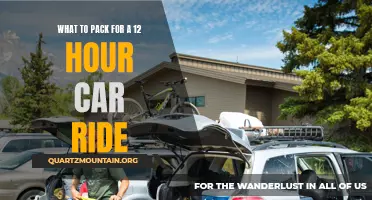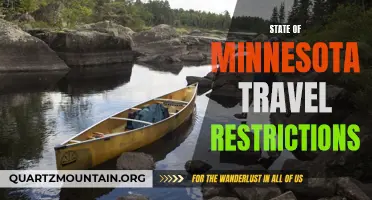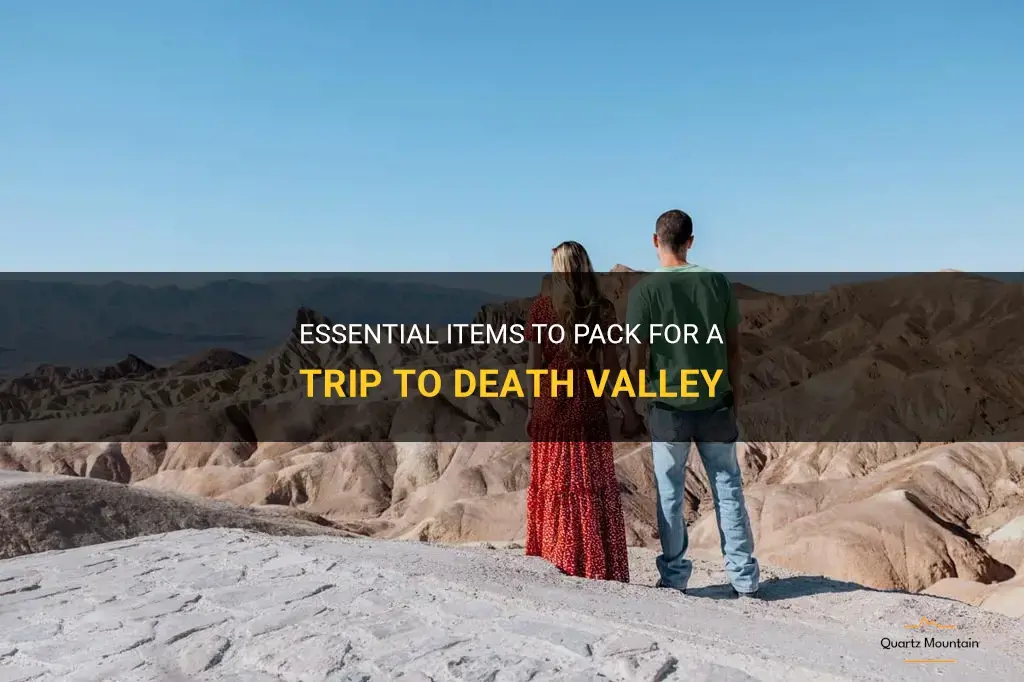
Have you ever wanted to embark on an adventure to one of the most extreme places on Earth? Death Valley National Park, located in California, is known for its scorching temperatures, vast desert landscapes, and unique geological formations. But before you head out on this exhilarating journey, it's essential to pack the right items to ensure your comfort, safety, and enjoyment during your trip. In this guide, we'll explore the must-have essentials to pack for a trip to Death Valley, making sure you're fully prepared for this unforgettable adventure.
| Characteristics | Values |
|---|---|
| Temperature | Hot |
| Sunscreen | Yes |
| Hat | Yes |
| Sunglasses | Yes |
| Water | Plenty |
| Light clothing | Yes |
| Hiking shoes | Yes |
| Snacks | Yes |
| First aid kit | Yes |
| Map/GPS | Yes |
What You'll Learn
- What clothing should I pack for a trip to Death Valley?
- What essentials should I include in my backpack when visiting Death Valley?
- Is there any specific gear or equipment I should pack for outdoor activities in Death Valley?
- Are there any specific items I need to have for staying hydrated in the extreme desert environment of Death Valley?
- Are there any safety precautions or emergency supplies I should bring when exploring Death Valley?

What clothing should I pack for a trip to Death Valley?
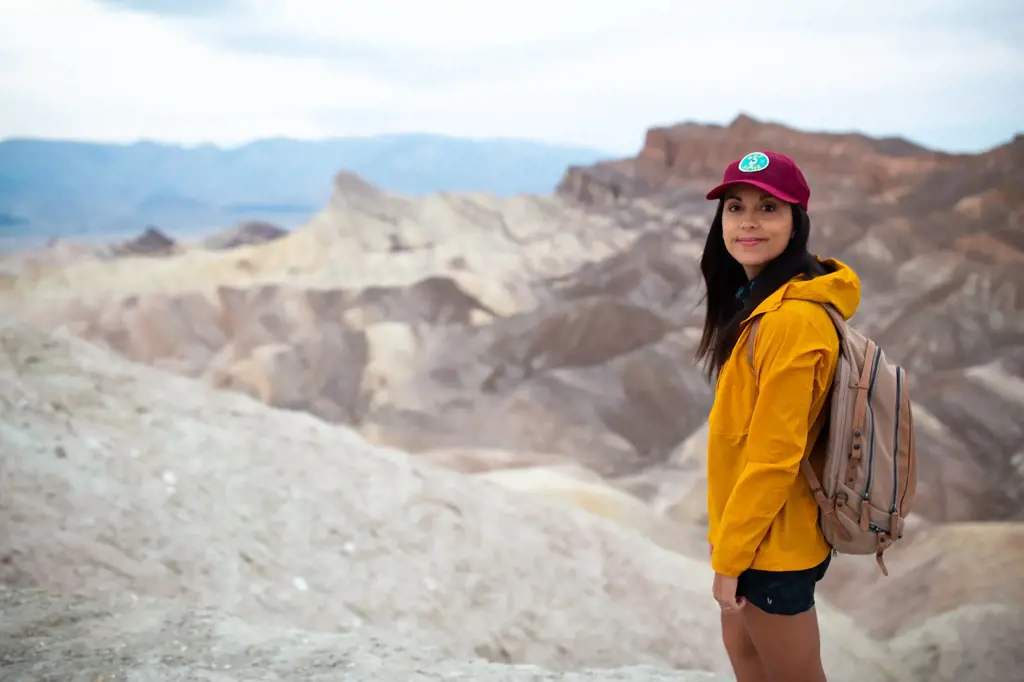
When planning a trip to Death Valley, it is important to pack the right clothing to ensure your safety and comfort in this extreme desert environment. With temperatures often reaching over 100 degrees Fahrenheit (37 degrees Celsius) during the day and dropping significantly at night, it is crucial to be prepared for the extreme weather conditions.
Here is a step-by-step guide on what clothing you should pack for a trip to Death Valley:
- Lightweight and breathable clothing: Opt for lightweight and breathable fabrics such as cotton or linen to help keep you cool in the scorching heat. Loose-fitting clothing also allows for better air circulation and helps to minimize perspiration.
- Sun protection: The desert sun can be intense, so it is essential to pack sun protection gear. A wide-brimmed hat or a cap with a neck flap will provide shade and protect your face, neck, and ears from the sun's rays. Don't forget to bring sunglasses with UV protection to shield your eyes.
- Long-sleeved shirts and pants: Despite the heat, it is advisable to pack long-sleeved shirts and pants to protect your skin from the sun. Lightweight, loose-fitting shirts with UPF (Ultraviolet Protection Factor) are a great option as they offer sun protection while allowing airflow.
- Layering options: Although Death Valley is known for its scorching temperatures, it can get chilly at night or in higher elevations. Packing a light sweater or a jacket is wise to keep you warm when the temperature drops. Layering allows you to adjust your clothing according to the fluctuating temperatures throughout the day.
- Closed-toe shoes: When exploring Death Valley, it is essential to have sturdy closed-toe shoes. Opt for comfortable hiking shoes or boots that provide support and protection for your feet. The terrain can be rugged, and you may encounter sharp rocks or cacti, so it's best to avoid sandals or flip-flops.
- Socks and hats: Don't forget to pack extra pairs of socks to keep your feet dry and blister-free, especially if you plan on hiking. Opt for moisture-wicking socks to help prevent excessive sweating. Additionally, a beanie or a headband can be useful during cooler evenings or if you plan on stargazing.
- Swimsuit: Death Valley offers unique opportunities for swimming or cooling off in natural springs or pools, such as the Devil's Golf Course or the Harmony Borax Works site. Packing a swimsuit will allow you to take advantage of these refreshing experiences.
Remember, hydration is crucial in the desert, so drinking plenty of water and carrying a refillable water bottle is essential. It is also important to check the weather forecast before your trip to ensure you are prepared for any changes in conditions.
In conclusion, packing the right clothing for a trip to Death Valley is key to staying safe and comfortable in the extreme desert environment. Lightweight, breathable fabrics, sun protection gear, long-sleeved shirts, pants, layering options, closed-toe shoes, socks, hats, and a swimsuit are all essential items to include in your packing list. By following these guidelines, you can enjoy your trip to Death Valley while staying comfortable and protected from the harsh elements.
Your Ultimate Guide to Packing for a Trek America Southern Sun Adventure
You may want to see also

What essentials should I include in my backpack when visiting Death Valley?
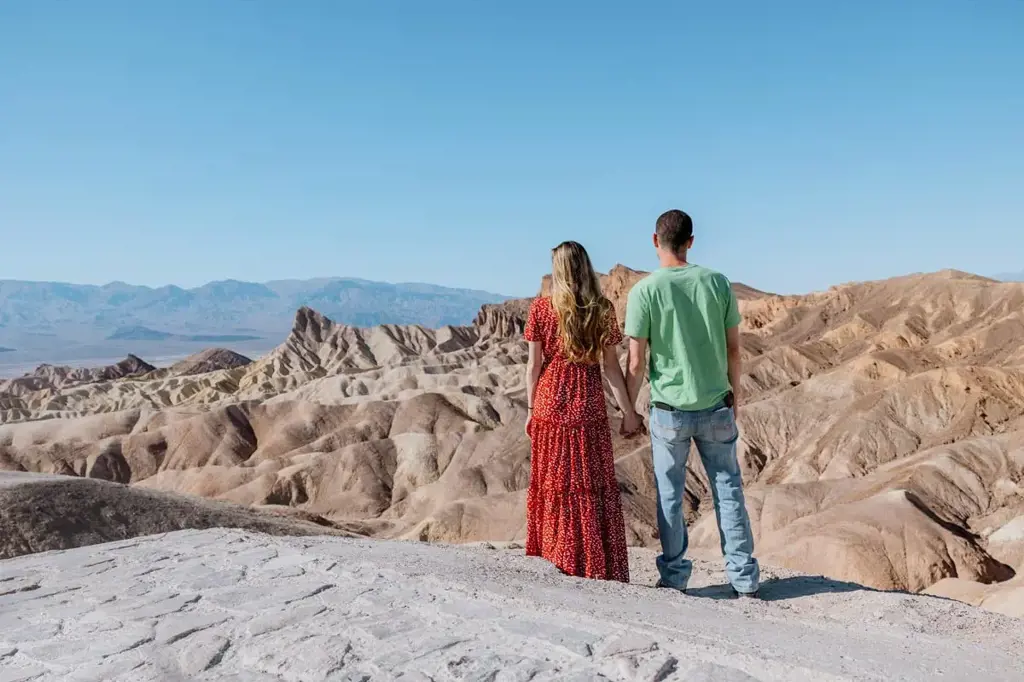
When planning a trip to Death Valley, it is important to pack your backpack with essentials that will ensure your safety and comfort in this harsh desert environment. Death Valley is known for its extreme temperatures and arid conditions, so it is crucial to come prepared. Here are some essentials that you should include in your backpack before heading to Death Valley.
- Water: This is the most important item to have in your backpack. The desert heat can quickly lead to dehydration, so be sure to bring enough water to last for your entire trip. It is recommended to bring at least one gallon of water per person per day. Consider using a hydration bladder or water bottles that are easy to carry and refill.
- Sun protection: The desert sun can be intense, so protect yourself from its harmful rays. Pack a wide-brimmed hat or a cap to shield your face and neck from the sun. Also, don't forget to bring sunscreen with a high SPF. Apply it generously and reapply it throughout the day to prevent sunburns.
- Clothing: Dress appropriately for the desert climate. Wear lightweight, loose-fitting clothes that provide coverage and protect you from the sun. Choose breathable fabrics like cotton or linen that will help to keep you cool. Don't forget to pack a light jacket or sweater for cooler evenings.
- Footwear: Invest in a good pair of hiking boots or sturdy closed-toe shoes for exploring Death Valley. The terrain can be rugged, and you'll want footwear that provides good traction and protects your feet. Also, make sure to bring comfortable socks to prevent blisters.
- Navigation tools: Death Valley is a vast desert with a complex network of trails and roads. It's easy to get disoriented, so bring navigation tools such as a map, compass, or GPS device. Familiarize yourself with the area before your trip and plan your routes accordingly. Additionally, carry a whistle or a signaling device in case of an emergency.
- First aid kit: Accidents can happen, so it's important to have a well-stocked first aid kit in your backpack. Include items like bandages, gauze, adhesive tape, antiseptic ointment, tweezers, and pain relievers. Carry any necessary prescription medications as well.
- Food: Pack lightweight, non-perishable snacks and meals that will provide you with sufficient energy for your adventures. Opt for foods that won't spoil in the heat, such as nuts, granola bars, dried fruits, and jerky. Don't forget to bring a portable stove or campfire cooking equipment if you plan on preparing hot meals.
- Emergency supplies: It's always better to be prepared for the worst. Include items like a flashlight, extra batteries, a whistle, a multi-tool, a lighter or matches, and a space blanket. These supplies can be crucial in case of an unexpected situation or if you get lost.
- Trash bags: Leave no trace when visiting Death Valley. Bring extra trash bags to pack out all your garbage and dispose of it properly. Protect the fragile desert environment by practicing responsible and sustainable tourism.
- Personal items: Lastly, don't forget to bring personal items such as a camera to capture the stunning landscapes, a notebook and pen to jot down your experiences, and any other items that will enhance your trip, such as binoculars or a field guide for wildlife spotting.
Remember that Death Valley is a remote and unforgiving environment. Be prepared, stay hydrated, and always prioritize your safety. With the right essentials in your backpack, you'll be ready to explore and appreciate the extraordinary beauty of Death Valley.
Essential Items for Packing for a Stay at Canyon Ranch Lenox
You may want to see also

Is there any specific gear or equipment I should pack for outdoor activities in Death Valley?
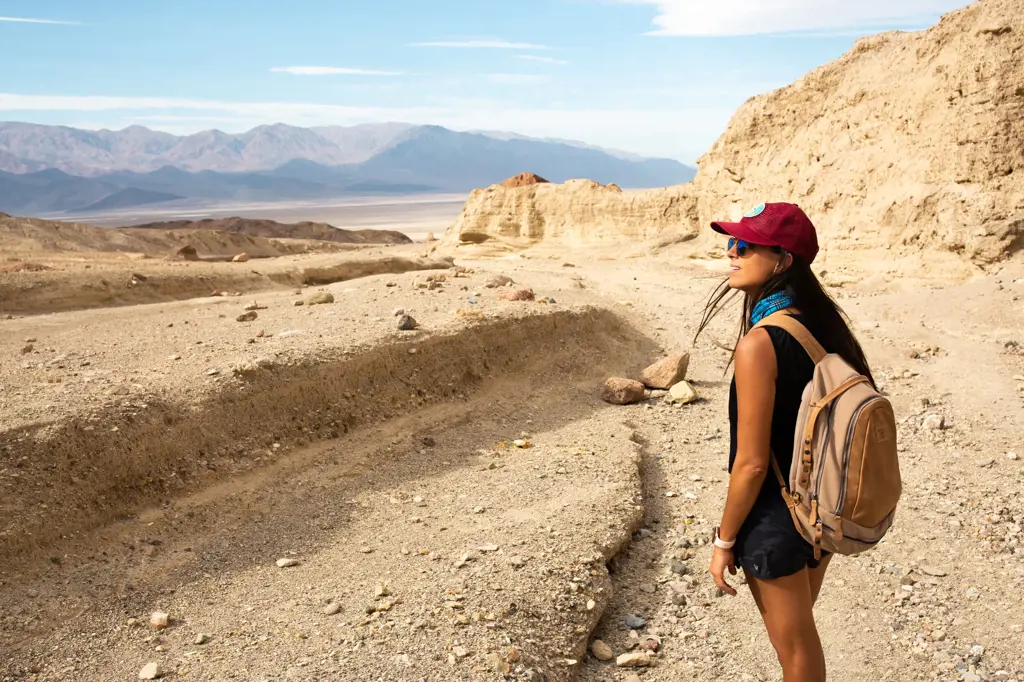
When planning a trip to Death Valley, it is important to pack the right gear and equipment to ensure a safe and enjoyable outdoor experience. The extreme temperatures and harsh desert environment of Death Valley can present unique challenges, so it's crucial to be prepared. Here are some essential items to consider packing for outdoor activities in Death Valley.
- Water: Staying hydrated is essential in Death Valley, especially during the hot summer months. Carry at least one gallon of water per person per day and drink regularly to avoid dehydration. It's also a good idea to have a water filtration system or purification tablets in case you need to refill your water from natural sources.
- Sun Protection: The desert sun can be unforgiving, so pack sunscreen with a high SPF rating, a wide-brimmed hat, and sunglasses to protect your skin and eyes from harmful UV rays. Additionally, lightweight and breathable clothing that covers your arms and legs can provide extra protection against the sun.
- Navigation Tools: Death Valley's vast and remote landscapes can be challenging to navigate, so having a map, compass, and a reliable GPS device is crucial. Familiarize yourself with the area and plan your routes in advance to avoid getting lost.
- First Aid Kit: Accidents can happen, so it's essential to have a well-stocked first aid kit with supplies like bandages, antiseptic ointment, pain relievers, and any necessary personal medication. Be prepared for common outdoor injuries such as blisters, cuts, and insect bites.
- Camping Gear: If you plan to camp in Death Valley, make sure you have the necessary camping gear. This includes a sturdy tent, sleeping bag, sleeping pad, and camping stove. Research beforehand if your chosen campsite requires reservations or permits.
- Extra Food: It's always a good idea to pack extra food in case of emergencies or unexpected delays. Choose lightweight, non-perishable items that provide a good balance of nutrients and energy.
- Proper Footwear: The trails in Death Valley can be rocky and uneven. Invest in a sturdy pair of hiking boots or trail shoes that provide ankle support and have good traction. Avoid open-toed sandals or flimsy footwear that may not protect your feet adequately.
- Layered Clothing: Death Valley experiences dramatic temperature fluctuations between day and night, so layering your clothing is essential. Pack lightweight, moisture-wicking base layers, insulating mid-layers, and a waterproof jacket in case of rain or wind.
- Communication Devices: In remote areas, cellphone coverage can be limited or nonexistent. Consider bringing a satellite phone, two-way radios, or a Personal Locator Beacon (PLB) for emergency communication.
- Trash Bags and Leave-No-Trace Principles: Help preserve the pristine beauty of Death Valley by following the Leave-No-Trace principles. Carry trash bags to pack out all your waste and dispose of it properly.
Remember that Death Valley is a unique and challenging environment, so it's crucial to do thorough research, check weather conditions, and inform others about your plans before venturing into the wilderness. By packing the right gear and equipment, you can have a safe and memorable outdoor experience in Death Valley.
Essential Items to Pack for a Memorable Trip to Delhi
You may want to see also

Are there any specific items I need to have for staying hydrated in the extreme desert environment of Death Valley?
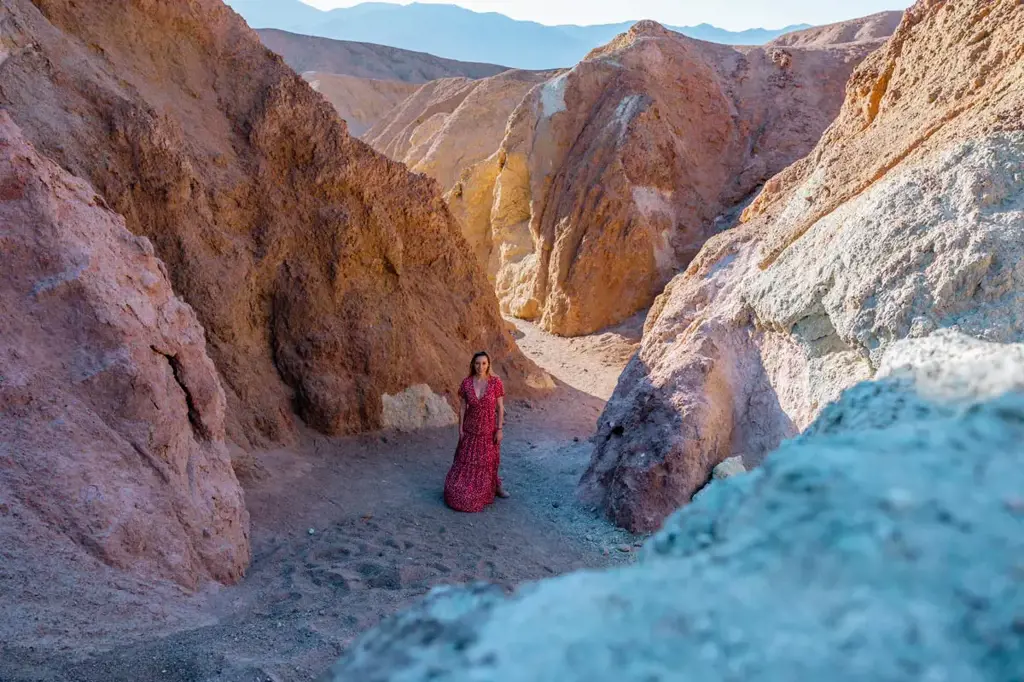
Staying hydrated in the extreme desert environment of Death Valley is crucial to avoid the risks of dehydration. The arid conditions, scorching heat, and low humidity can quickly deplete your body of fluids if you are not adequately prepared. Therefore, it is essential to have specific items to ensure you stay hydrated during your time in Death Valley.
- Water: The most important item to have for staying hydrated in Death Valley is water. Carry enough water to last you for the duration of your trip, and remember to drink regularly. The National Park Service recommends drinking at least one gallon (3.8 liters) of water per day, but you may need more depending on your activity level and the weather conditions.
- Water bottles: Invest in a sturdy and insulated water bottle to keep your water cold for longer periods. The extreme temperatures in Death Valley can quickly heat up your water, making it less refreshing to drink. A well-insulated water bottle will help keep your water cool and refreshing throughout the day.
- Electrolyte-rich beverages: Apart from water, it is also essential to replenish electrolytes lost through sweating. Electrolytes, such as sodium, potassium, and magnesium, are crucial for maintaining proper hydration and preventing muscle cramps. You can bring electrolyte-rich beverages like sports drinks or electrolyte tablets to replenish these minerals.
- Sunscreen: While sunscreen may not directly help with hydration, it plays a vital role in protecting your skin from the intense sun in Death Valley. Severe sunburns can dehydrate your body and make it more difficult to recover from the effects of heat. Choose a sunscreen with a high SPF and apply it liberally to all exposed areas of your body.
- Sun hat and sunglasses: Alongside sunscreen, a wide-brimmed hat and sunglasses are essential for protecting your face and eyes from the harsh sun. Direct exposure to the sun can lead to increased sweating and fluid loss. By shielding yourself from the sun's rays, you can prevent excessive sweating and minimize the risk of dehydration.
- Light, breathable clothing: Wearing lightweight, breathable clothing can help keep you cool and prevent excessive sweating. Opt for light-colored and loose-fitting clothes that allow air circulation. Avoid dark-colored clothing, as it tends to absorb more heat and can exacerbate the effects of the extreme temperatures.
- Cooling towels: Cooling towels are incredibly useful for staying cool in extreme desert environments. These towels are designed to cool upon contact with water and provide instant relief from the heat. Wet the towel and drape it around your neck or place it on your forehead to stay cool and prevent overheating.
Remember that staying hydrated is a continuous process, especially in a desert environment like Death Valley. Drink water regularly, even if you do not feel thirsty, and monitor your urine color to ensure you are adequately hydrated. By taking the necessary precautions and having the right items, you can enjoy your time in Death Valley while staying hydrated and healthy.

Are there any safety precautions or emergency supplies I should bring when exploring Death Valley?
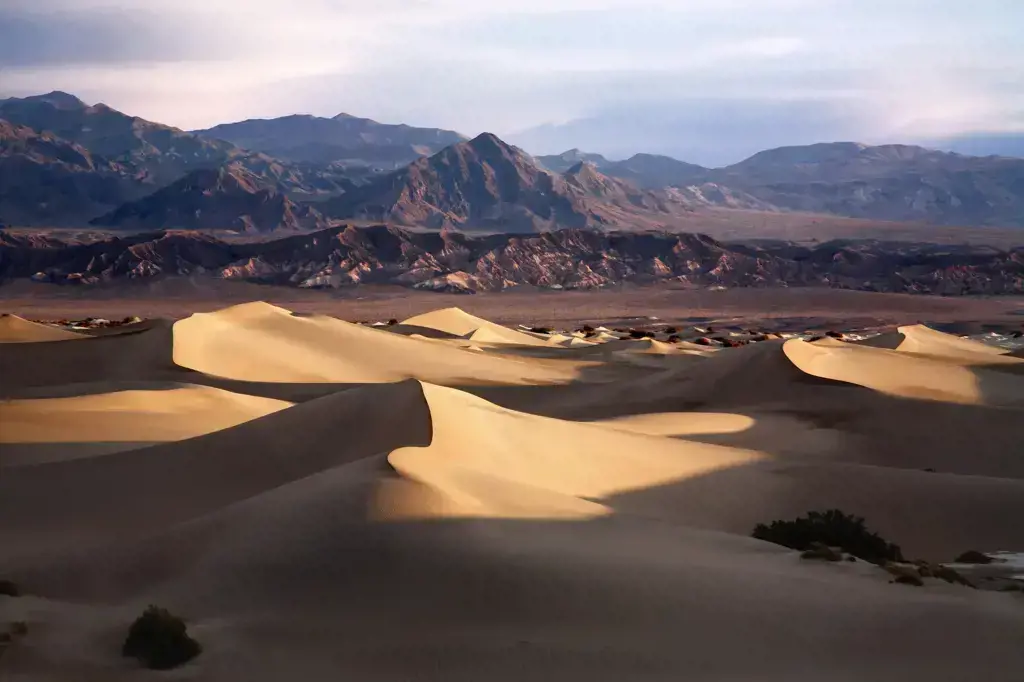
Exploring Death Valley can be a thrilling adventure, but it is important to prioritize safety and be prepared for any emergencies that may arise. Due to its extreme heat and remote location, Death Valley can be a challenging environment to navigate. Here are some safety precautions and emergency supplies you should consider bringing when exploring this unique National Park.
Be Prepared for Extreme Heat:
Death Valley is one of the hottest places on Earth, with temperatures often exceeding 120 degrees Fahrenheit (49 degrees Celsius). It is crucial to stay hydrated and protect yourself from the sun. Bring plenty of water, sunscreen, a hat, and lightweight, breathable clothing. Consider wearing a wide-brimmed hat and long-sleeved shirt to shield yourself from the intense sun.
Carry a Map and GPS:
Death Valley is vast and remote, with limited cell service in certain areas. It is essential to have a detailed map and a GPS device to navigate the park. Familiarize yourself with the park's geography and trail systems before embarking on your adventure. Always stick to marked trails and avoid venturing into unknown territories.
Inform Someone About Your Plans:
Before setting out on your trip, let a trusted friend or family member know about your travel plans. Provide them with a detailed itinerary, including your expected route, planned stops, and estimated return date. This information can be critical in case of an emergency or if you fail to return as planned.
Carry Emergency Supplies:
Even with the best planning, emergencies can happen. It is essential to pack emergency supplies to keep you safe while exploring Death Valley. Some essential items to consider include:
- First Aid Kit: A well-stocked first aid kit can help you address minor injuries and provide temporary relief until professional help arrives.
- Emergency Blanket: An emergency blanket can provide warmth in case you get stranded or injured and need to spend the night outdoors.
- Flashlight and Extra Batteries: A reliable flashlight and spare batteries are essential for navigating in the dark or signaling for help.
- Whistle: A whistle can be used to attract attention in case of an emergency.
- Food and Water: Carry non-perishable food and extra water in case you encounter delays or get stranded.
- Multi-tool: A multi-tool with pliers, a knife, and other handy features can be invaluable in survival situations.
Respect Wildlife and Park Regulations:
While exploring Death Valley, it is important to respect the park's wildlife and follow all regulations. Avoid approaching or feeding wild animals, as it can disrupt their natural behaviors and potentially lead to dangerous encounters. Additionally, always adhere to park rules, such as staying on designated trails and not disturbing any cultural or natural resources.
By following these safety precautions and being prepared with emergency supplies, you can have a safe and enjoyable experience while exploring Death Valley. Remember to always prioritize your safety and the well-being of the environment around you. With proper planning and caution, you can make the most of your adventure in this unique and awe-inspiring national park.
Essential Clothing Items to Pack for a Trip to Ukraine
You may want to see also
Frequently asked questions
When packing for your trip to Death Valley, it's important to be prepared for the extreme desert conditions. Here are a few essential items you should include in your packing list:
- Lightweight and breathable clothing: Opt for loose-fitting, light-colored clothes that will help protect you from the harsh sun and keep you cool. Don't forget a wide-brimmed hat, sunglasses, and sunscreen.
- Plenty of water: Staying hydrated is crucial in the desert, so make sure to bring enough water to last you throughout your visit. It's recommended to bring at least one gallon of water per person per day.
- Hiking essentials: If you plan on hiking in Death Valley, make sure to pack sturdy and comfortable shoes, as well as a map, compass, and GPS device. It's also a good idea to bring a first aid kit and a flashlight.
- Snacks and high-energy food: Packing lightweight snacks like trail mix, energy bars, and dried fruits can help keep your energy levels up during your visit.
- Camping gear: If you plan on camping in Death Valley, make sure to bring a tent, sleeping bag, and other necessary camping equipment.
Yes, even though Death Valley is known for its scorching temperatures, it can get quite chilly during the night. It's always a good idea to pack a few warm layers, such as a light jacket or sweater, to keep yourself comfortable when the temperature drops. Additionally, if you plan on visiting higher elevations or exploring the mountains in the area, you may encounter cooler temperatures, so it's best to be prepared.
While Death Valley is predominantly a desert region, it is home to various insects and bugs, including mosquitoes and flies. Although insects are not a significant issue in the park, it's always wise to bring some insect repellent to protect yourself from potential bites. Additionally, if you plan on camping in Death Valley, insect repellent is especially important to ward off any pests that may be present at your campsite. It's recommended to pack a DEET-based repellent or a natural alternative like citronella-based repellent.




